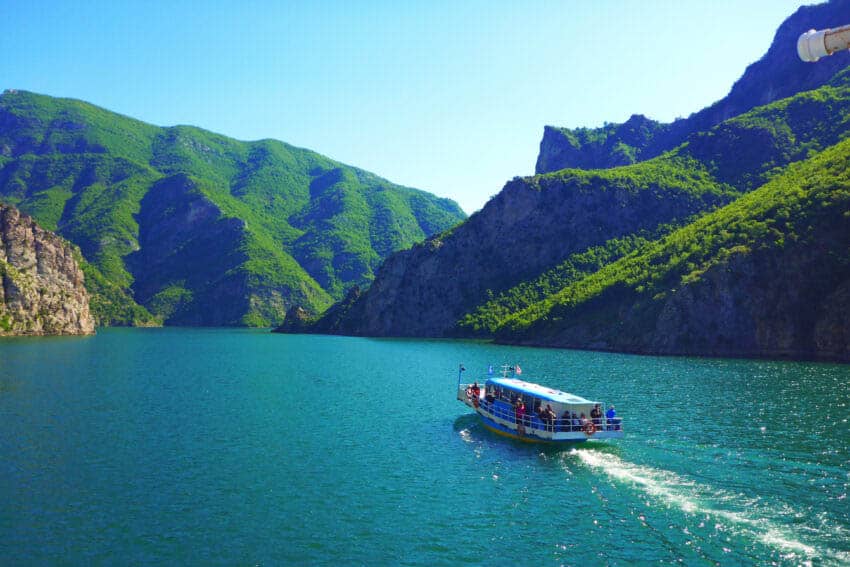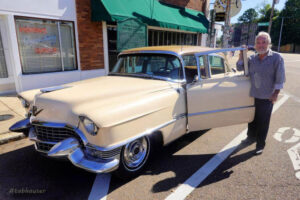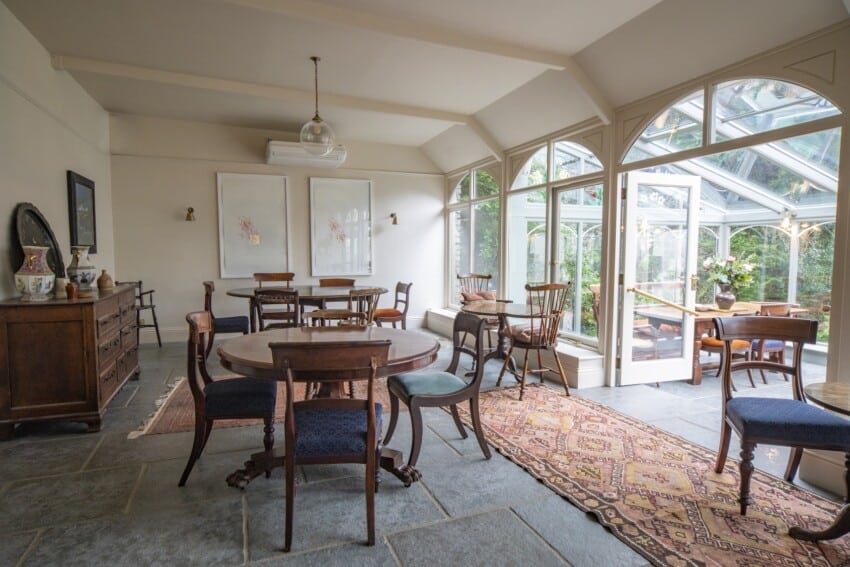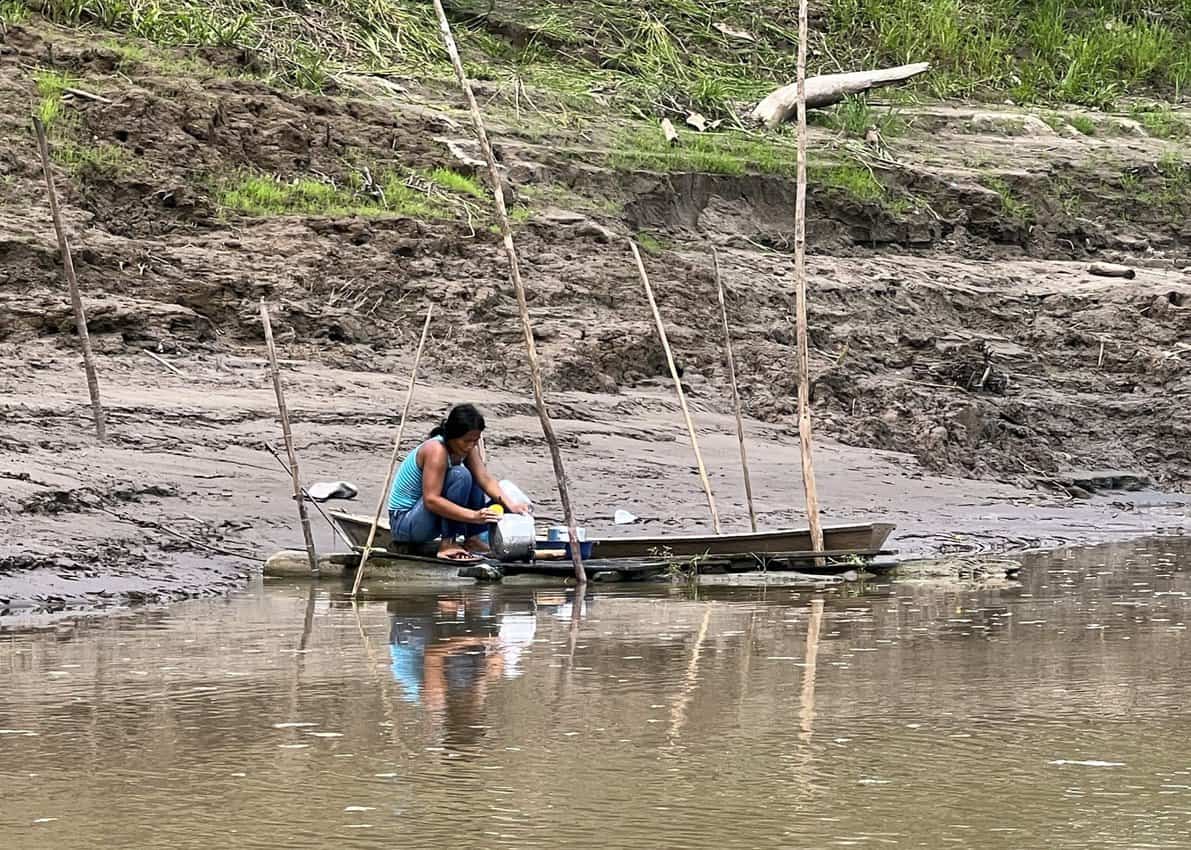By Max Hartshorne
Trust the Chef: Daniel Monopoli Keeps It Simple

Simple food appeals to this young chef, who’s made a name in just a few months by opening the Boat Shed Cafe on the waterfront in Nelson.
We sat with Daniel on his night off, as the restaurant revved up for another busy shift. He talked about his new idea, called “Trust the Chef,” that brings out five or six mystery dishes, so that everyone is eating throughout the evening.
“It’s not for everyone,” he admitted. But Daniel likes the share and sample way of eating, despite the fact that here in New Zealand, locals often expect a full plate with the requisite meat, starch and veggies.
He likes the movement and the idea that lots of different dishes arriving one after the other allows a more relaxed flow and promotes conversation.
We asked him about the way he does business, and he told us that he puts the whole staff on salary, despite the ebbs and flows of summer versus winter.
“That way they know they’ll get the same salary all year, and it keeps the turnover very low.” Everyone in the kitchen is on the same team, everyone cleans and he’s flattened the hierarchy.
Despite the legendary belief that no one in New Zealand likes to tip, he believes that it’s only fair to throw in some extra for great service. He pools the tips including the lowly dishwasher.

He has fond memories of a visit to America where he passed through Austin Texas and bought a 1965 Chevy Caprice. He drove it to California and shipped it back to Nelson.
Time spent in Thailand gave him a keen appreciation for presenting food simply, and letting a great piece of fish work its magic without a host of piled up garnishes and heavy sauces.
He can be tough on his fishmongers, demanding the peak of fresh and only stocking 3-4 kilos of each. They run out but while they’re available they’re as good as they can be.
He Sheared Enough Sheep To Pilot a Heli
Dion Edgar told us that it costs about $100,000 to complete training to become a helicopter pilot. He spent many years saving up money from shearing sheep at $3.00 each in the windy Falklands, Scotland and New Zealand.
“You can do 300 or more sheep per day,” he said, “it adds up.”
In front of us was a shiny red Eurocopter chopper that seated five plus the pilot. We were about to set off in a ferocious windstorm to fly up to Heaphy Track to hike one of most beautiful hiking trails ever created.

Watching the gusts flatten Dion’s windbreaker as he readied the craft out on the landing pad, I admit, I was a bit nervous. One of our guides, Amanda, nudged me as we were just about to take off, needling me for my trepidation… apparently these gusts are no match for our turbocharged European-designed, eight-year old heli, one of a fleet of 40 owned by HeliPro, a pilot owned company based in Wellington.
We went straight up, and then zoomed out over the Queen Charlotte Sound toward the distant snow capped peaks. Below us we could see large swaths of clear-cut mountains, and next to them the smaller trees which had been planted in their place.
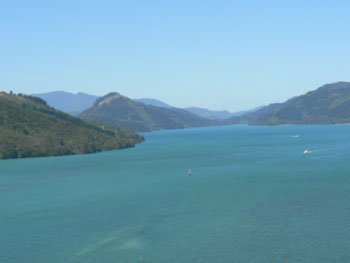
Even much of the tall tree forests were uniform in height, an indication they’d been planted in rows, to be harvested in 15-20 years.
We cruised at about 50 mph at 2000 feet, then climbed up to 6500 feet when we hit the mountains, the green tops giving way to more jagged peaks, which our guide Ryan said were called the Dragon’s Teeth.
Over there, he pointed, was where a few of Lord of the Rings scenes were filmed. We cruised with few clouds and perfect visibility below, yellow markings of roads crossed some of the logged mountainsides, and then there were none.
After about 20 minutes we popped down next to a sturdy structure with a tin roof, called Perry Saddle Hut. Inside are bunks, tables, a stove, and faucet, but no trash cans. Everything that comes in is coming out with you. Twenty-four hikers can stay here for the night.
These huts were built in the days when hunters sought out white-tailed deer to try and capture their tails. Then they realized they were a valuable meat they could sell, and intrepid Kiwis used to build crude landing strips on these jagged mountains to pile carcasses on fixed wing aircraft and bring them to market.
The pursuit came to a crescendo when the price of a breeding mare reached $2000, and helicopters were used to swoop down and try and net them live to be taken to a breeding farm. It was big money, but it was before Dion’s flying days.

After an 8 kilometer hike through a leafy canopy, and then out into the most ferocious wind I’ve ever experienced, we made it to a second hut, and while we hummed the MASH theme song, Dion again appeared over the horizon to swoop down and bring us back to Nelson.
Behind us a menacing plume of smoke was billowing out from a faraway forest… soon Dion would be heading that way to dump water on the fire from this same chopper.
Wine, Art & Wilderness… Kiwi Style
Yesterday I (Cindy) did something surprising….I realized and admitted that New Zealand is surpassing Italy as my favorite place.
It’s not just the beautiful, rugged scenery, the perfectly prepared and apportioned meals, nor is it the history or the art. Travel is about the people you meet. The shared experiences, the glimpses into each others’ lives. So far Kiwis rule!
The realization struck during my outing with Noel Kennedy of Wine, Art & Wilderness Tours. Noel has a background in landscape design, land conservation, and the wine business, and brings it all together as a tour guide in Nelson, a haven for artists and vineyards.
The lifestyle and climate appeal to the artists, while the soil, sun and ocean breezes provide the right setting for superb local wines.
Noel works with small, family operated wineries that are able to provide an educational experience to guests. After an al fresco lunch at The Mapua Boatshed Cafe, we sampled Pinot Noir, Chardonnay, and a stand-out Merlot Rose at the Kina Beach Vineyard, and finished out the day by visiting local artist Brian Strong, who paints striking landscapes filled with historical symbolism.
Noel’s contacts with the local wineries and artists offer his clients a personalized tour and experience you’re unlikely to get on your own. Add in his knowledge about all things Nelson and it’s a day you’ll not soon forget!
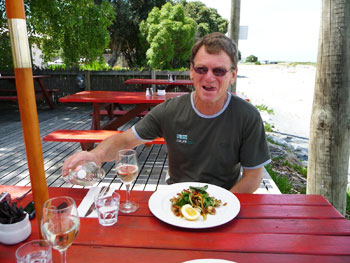
Noel is an easy going, unassuming guy who comes out with the most amazing facts and information…he’s a walking encyclopedia of knowledge of New Zealand’s plants, geology, local history and especially the wine business.
He shares it passionately and by the end of the day, I felt like family. That’s what it’s like here.
I’m off to visit with a local couple who share my passion of all things retro, as in 1960s design. It was arranged by Amanda Read of Southern Wilderness who hiked with us a few days ago.
When she learned of my retro interest she called her friends and…. poof! I’m invited for a visit to their home. Look what the universe provides…. more and more Kiwi friends at every turn!
I love Italy but New Zealand ROCKS!
Denuded NZ Hillsides Shock the Tourists
New Zealand’s main industries are fishing, forestry, horticulture and most important to us, tourism. That’s crucial for a visitor to keep in mind as we travel the South Island and see the clear-cut sections of hillsides, denuded right down to bare earth, which is such a common site here.
Many people make their living from those trees, so my first reaction, which is to be shocked, must be tempered with a little dose of reality. Clearcutting is a stark contrast to what some would prefer, selective harvesting. It would certainly look nicer if they could just remove some of the logs and leave other trees standing on those hills.
But as Dave Judson of Biking Nelson and I rode mountain bikes beside a barren hillside, he told me some facts about the operation, which gave good reasons for this style of timber harvesting.
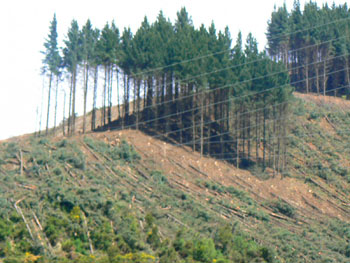
The timber is planted just like rows of crops, uniform plantings of the hardiest and fast-growing pine trees that they can genetically engineer in the forestry labs here.
After the trees are stripped of branches, the litter is collected into rows and left to decompose.
Then thousands of four-inch seedlings are hand planted on every denuded hillside. The trees are taken to Nelson’s harbor where they are shipped either to a nearby lumber mill in Richmond, or overseas.
Some of the wood goes to Japan’s largest paper company, Sumitomo, and some of the wood that’s left over is cut up for firewood and donated to seniors.
Ryan Kelly, a guide who took us to the Heaphy Track, said that it makes sense to use the timber in this way. Since the clearcutting is only done in these swaths, often right next to unusable stands of Beech that don’t get cut down, it’s good use of the land.
It also cuts way down on the potential for wildfires since dead wood and brush won’t pile up in the forests the way it does in our Western states.
A bigger threat than logging in New Zealand’s huge parklands are proposals to allow mining for iron ore, chromite, and gold, which would really destroy these beautiful lands.
So far most of the very green citizens here reject that notion.. but Australia’s wealth comes mostly from its vast mines so if they really wanted to increase the GDP, mining is the quickest answer
- Skiing in Georgia - February 21, 2024
- Exciting Rail Travel News in 2024 - February 4, 2024
- Last Minute Gifts for Christmas - December 17, 2023


